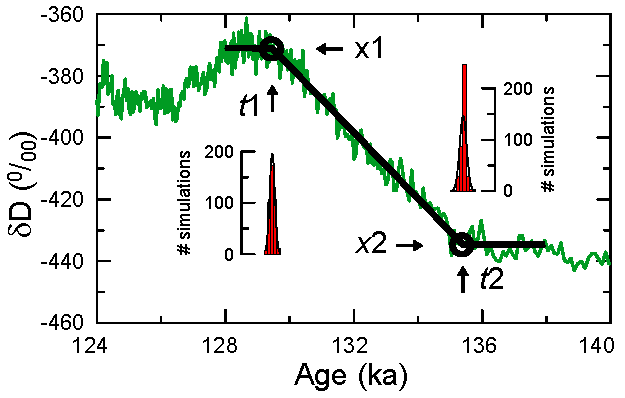|
Climate Sensitivity during and between Interglacials (ClimSens) Principal Investigators: Manfred Mudelsee (AWI Bremerhaven), Gerrit Lohmann (AWI Bremerhaven), Peter Köhler (AWI Bremerhaven)
Project Scientists: Manfred Mudelsee (AWI Bremerhaven)

Determination of interglacial/glacial boundaries. Fit of a ‘ramp’ function (thick black line) with four parameters (t1, x1, t2, x2; circled) to time series (green line). Also shown: bootstrap histograms (red) and Gaussian probability density functions (thin black lines) as measures of uncertainty for estimated change-points in time (t1, t2). The example shows the EDC deuterium record across Termination II, from the glacial stage at MIS 6 (t2, x2) to the interglacial beginning with MIS 5.5 (t1, x1). (Modified after Röthlisberger et al. (2008) Climate of the Past 4:345–356.)
Climate sensitivity is the temperature response following a change in radiative forcing (e.g., doubling of atmospheric carbon dioxide concentration). The value of this parameter is currently not well known, which limits the accuracy of projections of climate in the future (21st century and beyond). The ClimSens project is devoted to increasing the accuracy of climate sensitivity estimation by means of (1) employing long temperature and forcing time series and (2) implementing a state-of-the-art statistical estimation method. The time series come from climate models, ice cores and marine climate archives; they cover the past 800 thousand years. The estimation tool consists in errors-in-variables regression combined with a bootstrap resampling approach for a realistic accuracy determination; an innovative methodical step is that timescale uncertainties are explicitly taken into account. The regression model fitted to the time series leads to new sensitivity estimates of likely higher accuracy. ClimSens further studies how the sensitivity varied between past interglacials to obtain insight into the size of paleoclimate feedback processes. Results are expected to be relevant for enhancing our knowledge about the future climate evolution of the present interglacial through the 21st century and beyond.
Methods Marine records from globally distributed sites, ice cores
Archives
Marine records (eastern margin of South America)
|
| < zurück |
|---|

